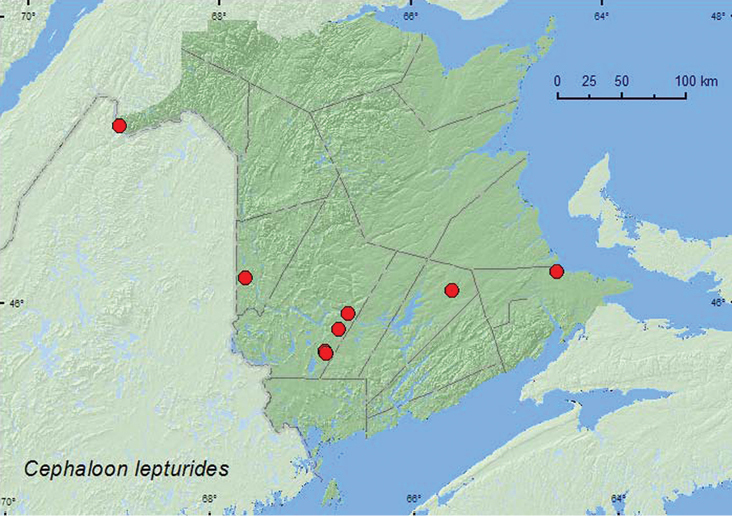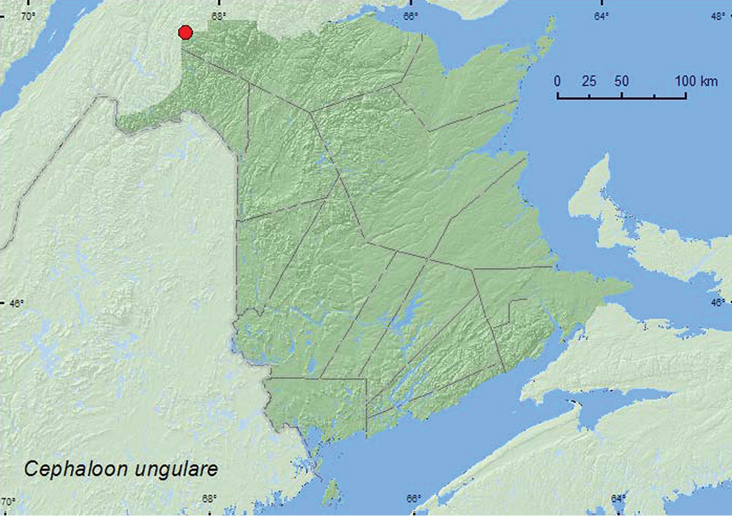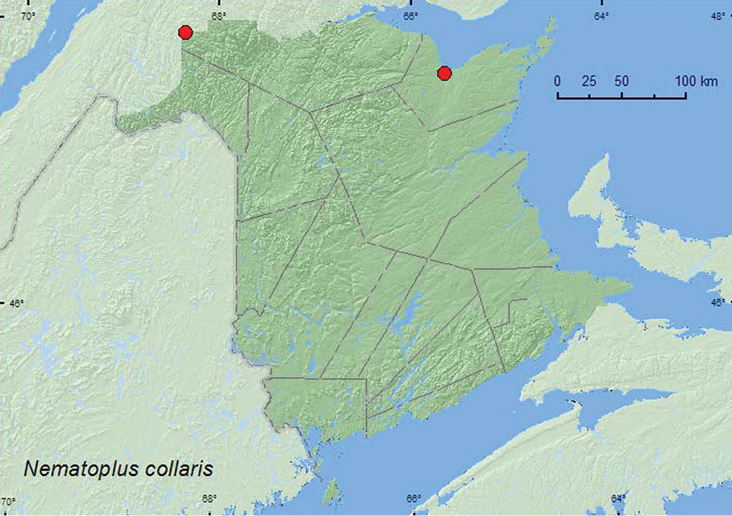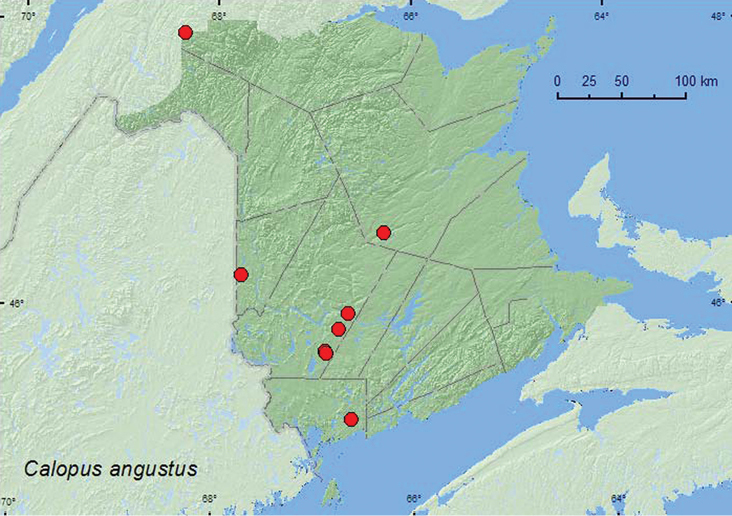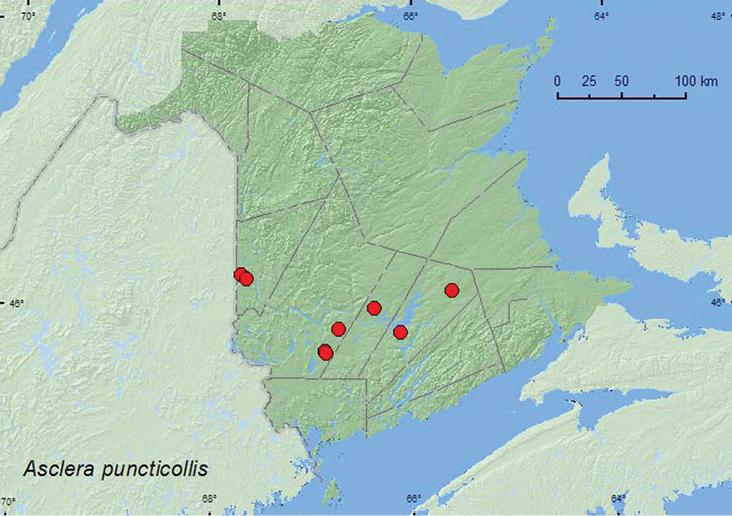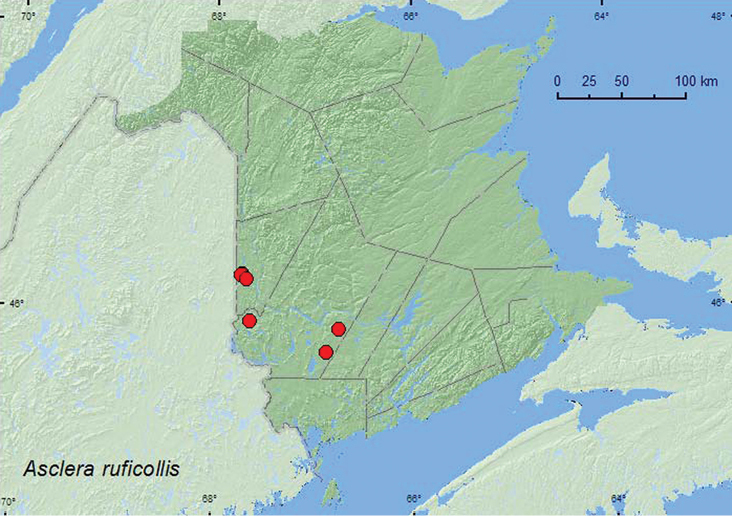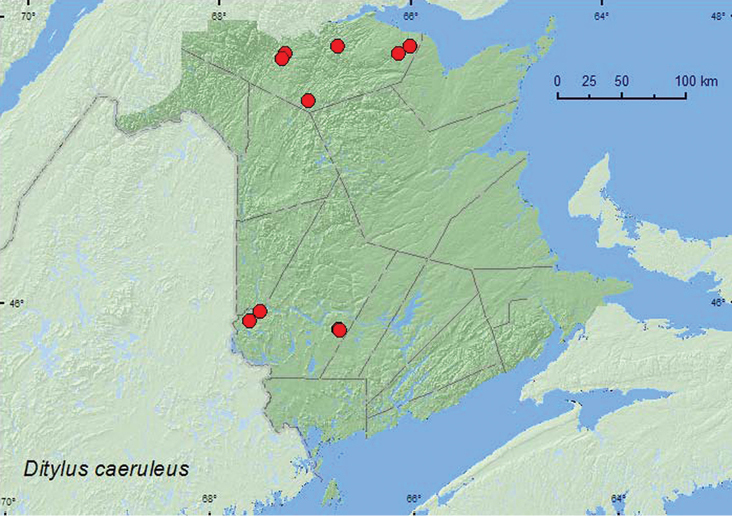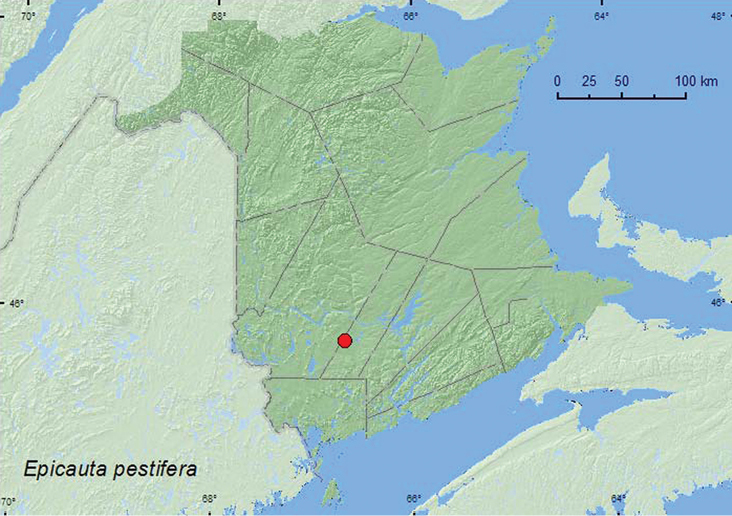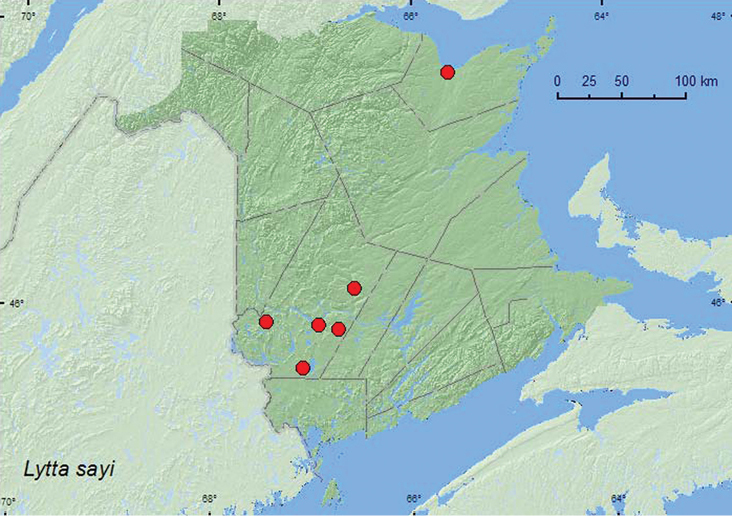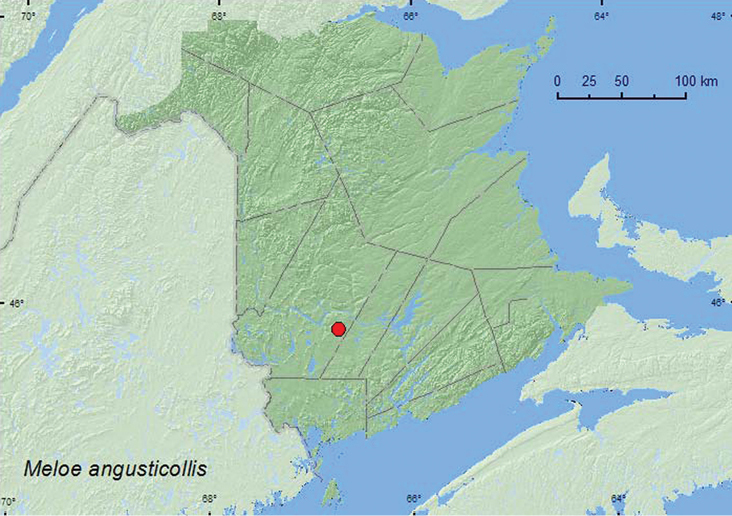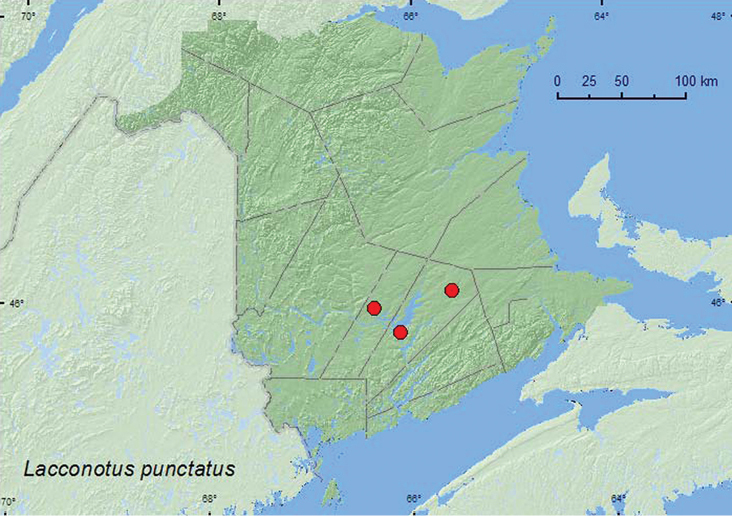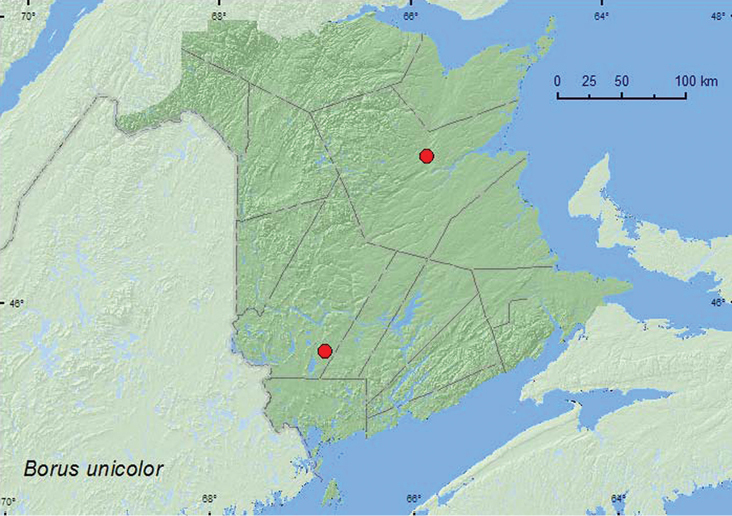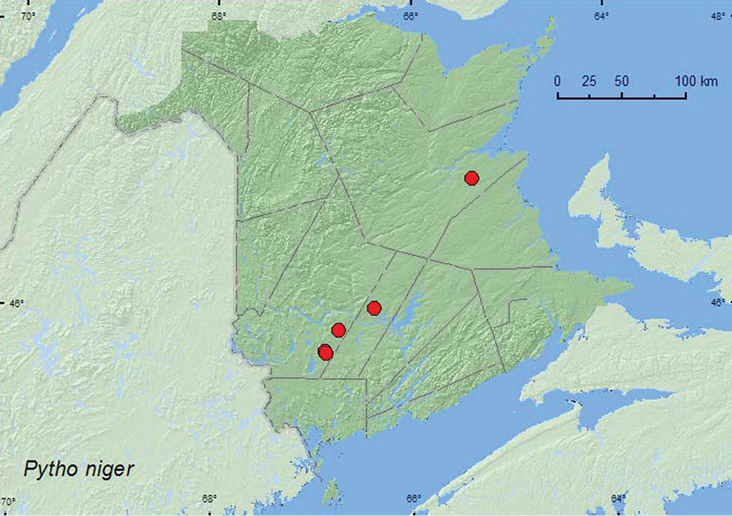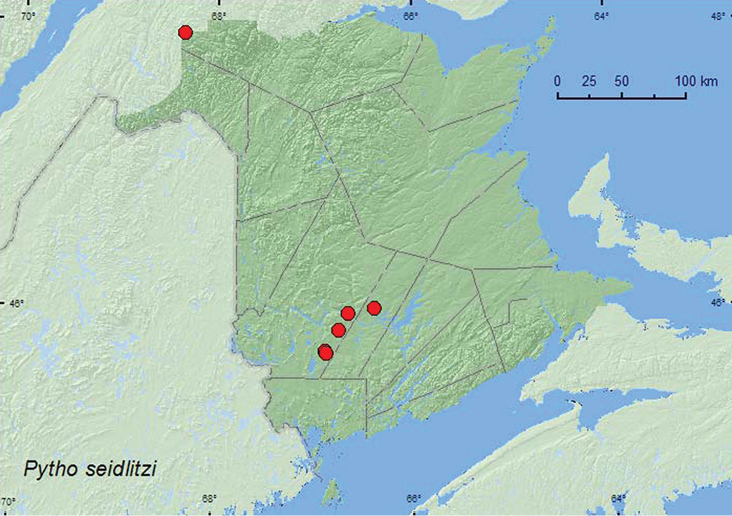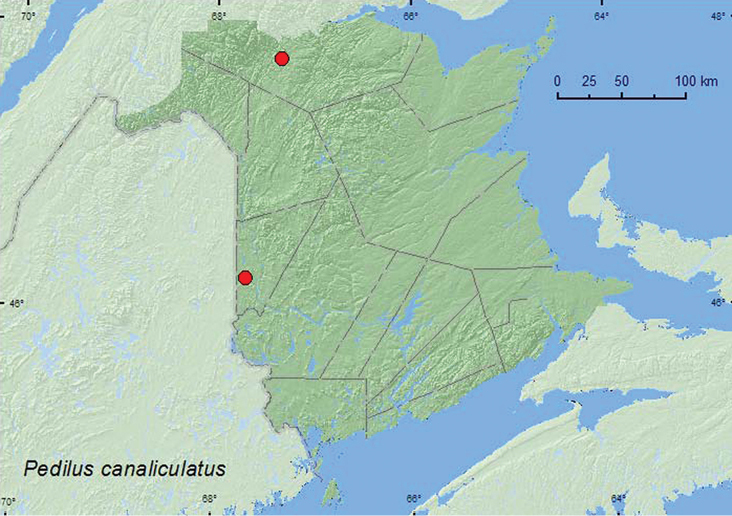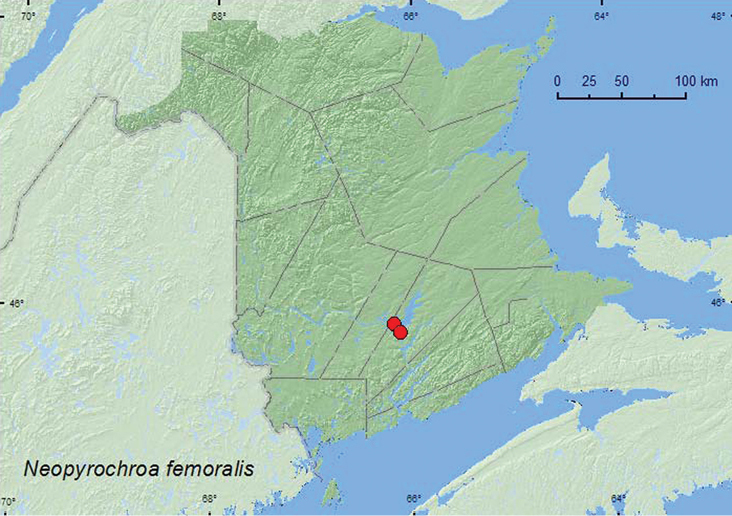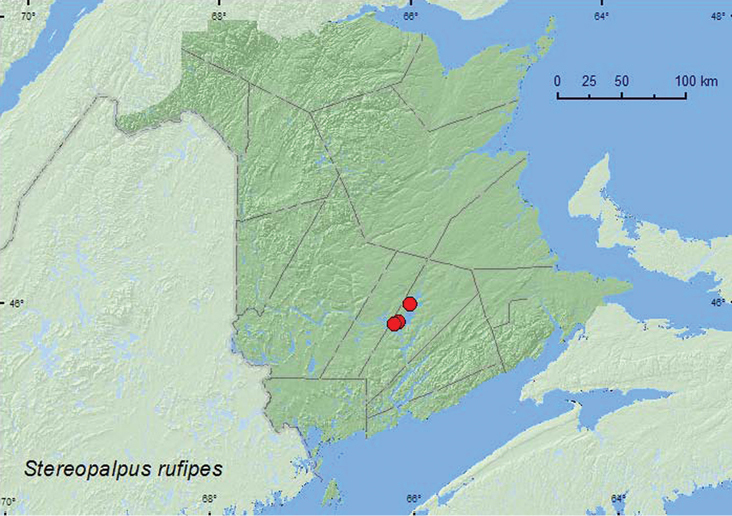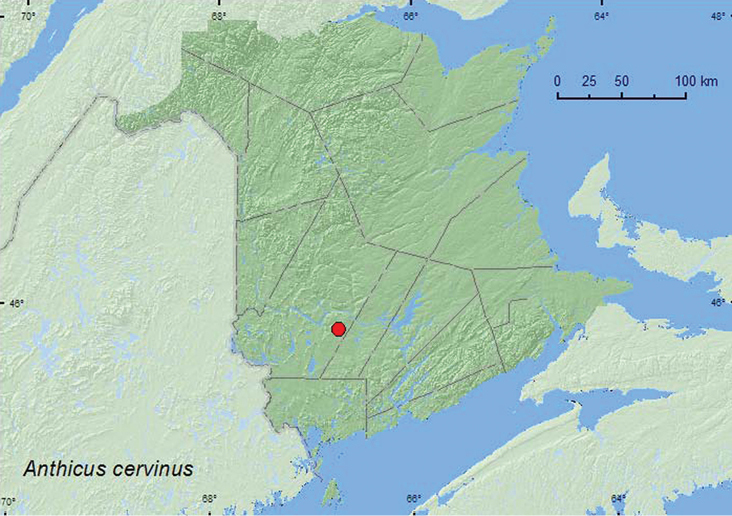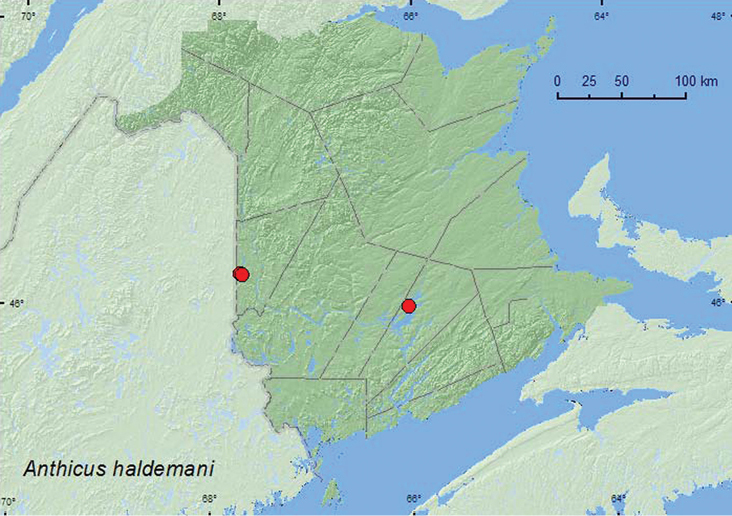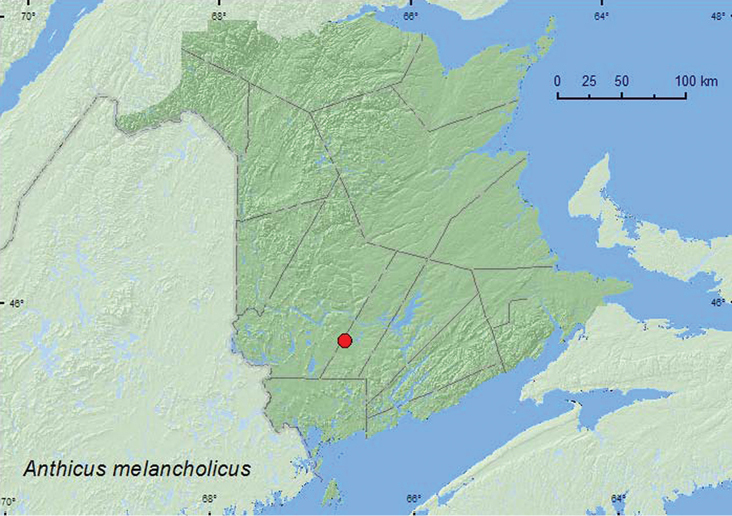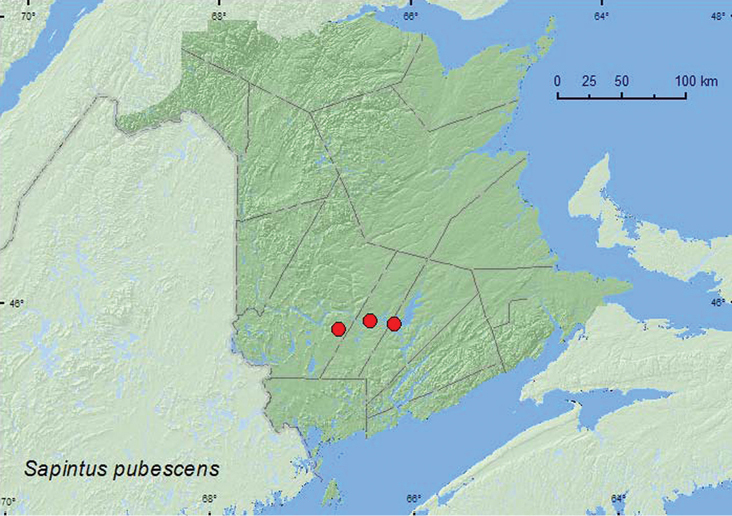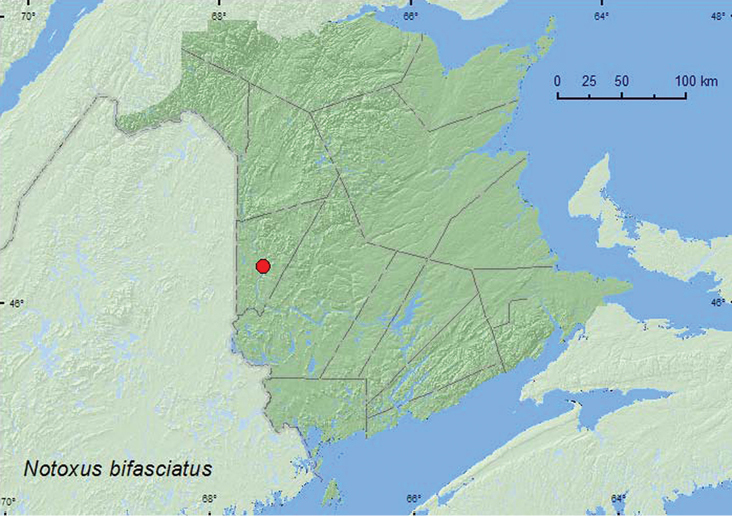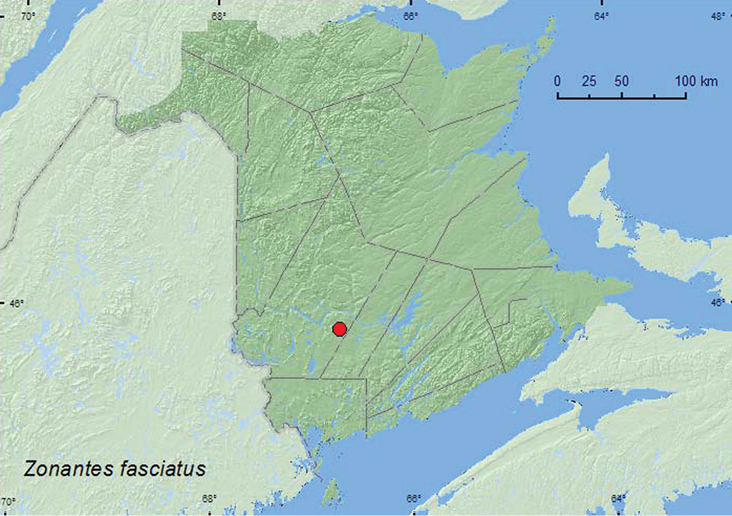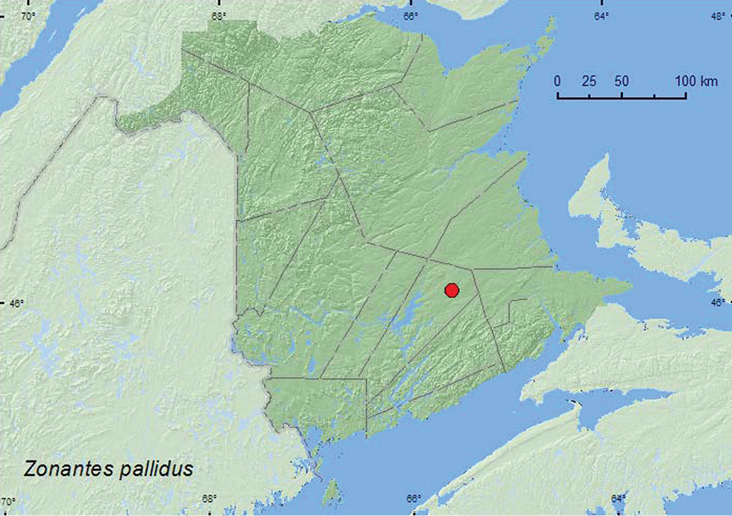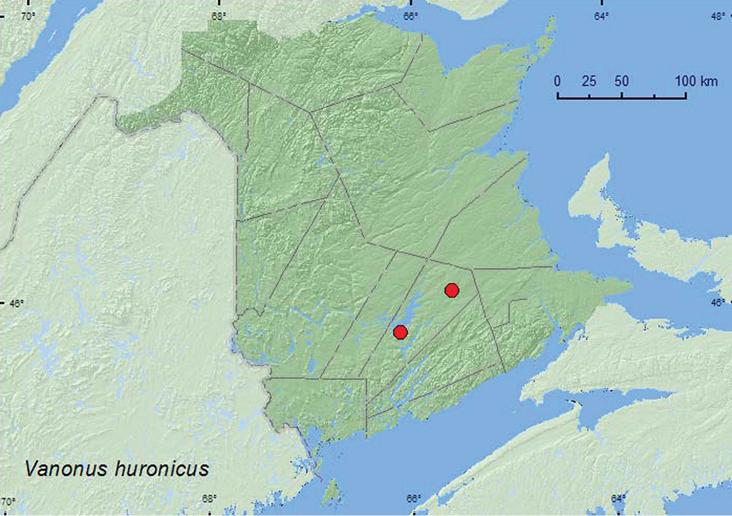






(C) 2012 Reginald P. Webster. This is an open access article distributed under the terms of the Creative Commons Attribution License 3.0 (CC-BY), which permits unrestricted use, distribution, and reproduction in any medium, provided the original author and source are credited.
For reference, use of the paginated PDF or printed version of this article is recommended.
We report 19 new species records for the faunal list of Coleoptera in New Brunswick, Canada, six of which are new records for the Maritime provinces, and one of which is new Canadian record. We also provide the first recent records for five additional species in New Brunswick. One new species of Stenotrachelidae, Cephaloon ungulare LeConte, is added to the New Brunswick faunal list. Additional records are provided for Cephaloon lepturides Newman, as well the first recent record of Nematoplus collaris LeConte. Two species of Oedemeridae, Asclera puncticollis (Say) and Asclera ruficollis (Say), are newly reported for New Brunswick, and additional locality and bionomic data are provided for Calopus angustus LeConte and Ditylus caeruleus (Randall). The records of Ditylus caerulus are the first recent records for the province. Three species of Meloidae, Epicauta pestifera Werner, Lytta sayi LeConte, and Meloe augustcollis Say are reported the first time for New Brunswick; Epicauta pestifera is newly recorded in Canada. Lacconotus punctatus LeConte and the family Mycteridaeis newly recorded for New Brunswick. The first recent records of Borus unicolor Say (Boridae) are reported from the province. One new species of Pythidae, Pytho siedlitzi Blair, and the first recent records of Pytho niger Kirby are added to the faunal list of New Brunswick. Three species of Pyrochroidae are newly reported for the province, including Pedilus canaliculatus (LeConte) and Pedilus elegans (Hentz), which are new for the Maritime provinces. Five species of Anthicidae and the first recent record of Anthicus cervinus LaFerté-Sénectére are newly reported for New Brunswick. Anthicus melancholicus LaFerté-Sénectère, Sapintus pubescens (LaFerté-Sénectère), Notoxus bifasciatus (LeConte), and Stereopalpus rufipes Casey are new to the Maritime provinces faunal list. Ambyderus granularis (LeConte) is removed from the faunal list of the province. Three species of Aderidae, Vanonus huronicus Casey, Zonantes fasciatus (Melsheimer), and Zonantes pallidus Werner, are newly recorded for New Brunswick; Zonantes fasciatus and Vanonus huronicus are new for the Maritime provinces’ faunal list. Collection data, bionomic data, and distribution maps are presented for all these species.
Stenotrachelidae, Oedemeridae, Meloidae, Myceteridae, Boridae, Pythidae, Pyrochroidae, Anthicidae, Aderidae, new records, Canada, New Brunswick
This paper treats new records from New Brunswick, Canada of a number of smaller families of beetles in the Tenebrionoidea: the Stenotrachelidae, Oedemeridae, Meloidae, Myceteridae, Boridae, Pythidae, Pyrochroidae, Anthicidae, and Aderidae. The fauna of most of these families from New Brunswick and Atlantic Canada was recently treated by
The following records are based on specimens collected during a general survey by the first author to document the Coleoptera fauna of New Brunswick and from by-catch samples obtained during a study to develop a general attractant for the detection of invasive species of Cerambycidae. Additional records (including data from the Forest Insect and Disease Survey (FIDS) slips) were obtained from specimens contained in the collection belonging to Natural Resources Canada, Canadian Forest Service - Atlantic Forestry Centre, Fredericton, New Brunswick.
Collection methodsVarious methods were employed to collect the species reported in this study. Details are outlined in
Distribution maps, created using ArcMap and ArcGIS, are presented for each species in New Brunswick. Every species is cited with current distribution in Canada and Alaska, using abbreviations for the state, provinces, and territories. New records for New Brunswick are indicated in bold under Distribution in Canada and Alaska. Acronyms of collections examined or where specimens reside referred to in this study are as follows:
| AK | Alaska | MB | Manitoba |
| YT | Yukon Territory | ON | Ontario |
| NT | Northwest Territories | QC | Quebec |
| NU | Nunavut | NB | New Brunswick |
| BC | British Columbia | PE | Prince Edward Island |
| AB | Alberta | NS | Nova Scotia |
| SK | Saskatchewan | NF & LB | Newfoundland and Labrador* |
* Newfoundland and Labrador are each treated separately under the current Distribution in Canada and Alaska.
The following abbreviations are used in the text:
AFC Atlantic Forestry Centre, Natural Resources Canada, Canadian Forest Service, Canada
CNC Canadian National Collection of Insects, Arachnids and Nematodes, Agriculture and Agri-Food Canada, Ottawa, Ontario, Canada
NBM New Brunswick Museum, Saint John, New Brunswick, Canada
RWC Reginald P. Webster Collection, Charters Settlement, New Brunswick, Canada
Results Species accountsAll records below are species newly recorded for New Brunswick, Canada, unless noted otherwise (additional record). Species followed by ** are newly recorded from the Maritime provinces (New Brunswick, Nova Scotia, Prince Edward Island) of Canada; species followed by *** are newly recorded for Canada.
The classification of the Stenotrachelidae, Oedemeridae, Meloidae, Myceteridae, Boridae, Pythidae, Pyrochroidae, Anthicidae, and Aderidae follows
Species of Stenotrachelidae, Oedemeridae, Meloidae, Myceteridae, Boridae, Pythidae, Pyrochroidae, Anthicidae, and Aderidae known from New Brunswick, Canada.
| Family Stenotrachelidae Thomson |
| Subfamily Cephaloinae LeConte |
| Cephaloon lepturides Newman |
| Cephaloon ungulare LeConte* |
| Subfamily Nematoplinae |
| Nematoplus collaris LeConte |
| Family Oedemeridae Latreille |
| Subfamily Calopodinae Costa |
| Calopus angustus LeConte |
| Subfamily Oedemerinae Latreille |
| Tribe Asclerini Gistel |
| Asclera puncticollis (Say)* |
| Asclera ruficollis (Say)* |
| Tribe Ditylini Mulsant |
| Ditylus caeruleus (Randall) |
| Tribe Nacerdini Mulsant |
| Nacerdes melanura (Linnaeus) |
| Family Meloidae Gyllenhal |
| Subfamily Meloinae Gyllenhal |
| Tribe Epicautini Parker and Böving |
| Epicauta murina (LeConte) |
| Epicauta pennsylvanica (DeGeer) |
| Epicauta pestifera Werner*** |
| Tribe Lyttini Solier |
| Lytta sayi LeConte** |
| Tribe Meloini Gyllenhal |
| Meloe angusticollis Say* |
| Meloe impressus Kirby |
| Family Mycteridae Oken |
| Subfamily Eurypinae Thomso |
| Lacconotus punctatus LeConte* |
| Family Boridae Thomson |
| Borus unicolor Say |
| Lecontia discicollis (LeConte) |
| Family Pythidae Solier |
| Priognathus monilicornis (Randall) |
| Pytho americanus Kirby |
| Pytho niger Kirby |
| Pytho seidlitzi Blair* |
| Pytho strictus LeConte |
| Family Pyrochroidae |
| Subfamily Pedilinae Lacordaire |
| Pedilus canaliculatus (LeConte)** |
| Pedilus elegans (Hentz)** |
| Pedilus lugubris (Say) |
| Subfamily Pyrochroinae Latreille |
| Dendroides canadensis Latreille |
| Dendroides concolor (Newman) |
| Neopyrochroa femoralis (LeConte)* |
| Schizotus cervicalis Newman |
| Family Anthicidae Latreille |
| Subfamily Eurygeniinae LeConte |
| Stereopalpus rufipes Casey** |
| Subfamily Anthicinae Latreille |
| Amblyderus pallens (LeConte |
| Anthicus cervinus LaFerté-Sénectère |
| Anthicus coracinus LeConte |
| Anthicus flavicans LeConte |
| Anthicus haldemani LeConte* |
| Anthicus heroicus Casey |
| Anthicus melancholicus LaFerté-Sénectère** |
| Anthicus scabriceps LeConte |
| Malporus formicarius (LaFerté-Sénectère) |
| Omonadus floralis (Linnaeus) |
| Omonadus formicarius (Goeze) |
| Sapintus pubescens (LaFerté-Sénectère)** |
| Sapintus pusillus (LaFerté-Sénectère) |
| Subfamily Notoxinae Stephens |
| Notoxus anchora Hentz |
| Notoxus bifasciatus (LeConte)** |
| Family Aderidae Csiki |
| Tribe Euglenesini Seidlitz |
| Zonantes fasciatus (Melsheimer)** |
| Zonantes pallidus Werner* |
| Tribe Aderini Csiki |
| Vanonus wickhami Casey |
| Vanonus huronicus Casey** |
The Stenotrachelidae is a small family of beetles with only nine species known from Canada (
Additional New Brunswick records, Carleton Co., Meduxnekeag Valley Nature Preserve, 46.1957°N, 67.6803°W, 28.VI.2005, R. P. Webster, mixed forest, u.v. light trap (1, RWC); “Bell Forest”, 46.2200°N, 67.7231°W, 27.VI–5.VII.2008, R. P. Webster, Rich Appalachian hardwood forest with some conifers, Lindgren funnel trap (1, AFC). Madawaska Co., Glasier Lake, 3.VII.1968 (D. Durling), 68–2-1721–02, on balsam fir (1, AFC). Queens Co., Cranberry Lake P.N.A. (Protected Natural Area), 46.1125°N, 65.6075°W, 29.VI–7.VII.2011, M. Roy & V. Webster, old red oak forest, Lindgren funnel trap (1, NBM). York Co., Fredericton, 29.VI.1936, R. E. Balch (1, AFC); Durham, 15.VII.1958, G. W. Barter (1, AFC), New Maryland (Charters Settlement), 45.8395°N, 66.7391°W, 23.VI.2003, 26.VI.2003, R. P. Webster, mixed forest, u.v. light (6, RWC); same locality data and collector, 19.VI.2004, mixed forest, on flowers of mountain ash (1, RWC); 15 km W of Tracy off Rt. 645, 45.6848°N, 66.8821°W, 8–15.VI.2009, 15–21.VI.2009, R. Webster & M.-A. Giguère, old red pine forest, Lindgren funnel traps (7, AFC); 14 km WSW of Tracy, S of Rt. 645, 45.6741°N, 66.8661°W, 22.V–2.VI.2010, R. Webster & C. MacKay, old mixed forest with red and white spruce, red and white pine, balsam fir, eastern white cedar, red maple, and Populus sp., Lindgren funnel trap (1, AFC).
This species was found in a rich Appalachian hardwood forest with some conifers, mixed forests, an old red oak (Quercus rubra L.) forest, and an old red pine (Pinus resinosa Ait.) forest. Specimens were collected from flowers of mountain ash (Sorbus sp.), at an ultraviolet light, on balsam fir (Abies balsamea (L.) Mill.), and in Lindgren funnel traps. In New Brunswick, adults were captured during May, June, and July.
ON, QC, NB, NS, PE (
Collection localities in New Brunswick, Canada of Cephaloon lepturides.
New Brunswick, Restigouche, Co., Dionne Brook P.N.A., 47.9064°N, 68.3441°W, 27.VI–14.VII.2011, 14–28.VII.2011, M. Roy & V. Webster, old-growth balsam fir and white spruce forest, Lindgren funnel traps (3, RWC); same locality and collector but 47.9030°N, 68.3503°W, 14–28.VII.2011, old-growth northern hardwood forest, Lindgren funnel trap (1, NBM).
Cephaloon ungulare was collected in an old-growth balsam fir and white spruce (Picea glauca (Moench) Voss) forest and an old-growth northern hardwood forest. Adults were captured in Lindgren funnel traps during July. Most specimens of this species have been captured in flight-intercept or malaise traps in coniferous-dominated forests (
Additional New Brunswick record, Restigouche, Co., Dionne Brook P.N.A., 47.9064°N, 68.3441°W, 27.VI–14.VII.2011, M. Roy & V. Webster, old-growth balsam fir and white spruce forest, flight intercept trap (1, RWC).
One individual of this species was captured between late June and mid July in a flight-intercept trap deployed in an old-growth balsam fir and white spruce forest.
ON, QC, NB (
Collection localities in New Brunswick, Canada of Nematoplus collaris.
The Oedemeridae (the false blister beetles) are usually found on flowers, foliage, and under driftwood and are often attracted to lights (
Additional New Brunswick records, Carleton Co., Jackson Falls, Bell Forest, 46.2200°N, 67.7231°W, 6.V.2007, R. P. Webster, mature hardwood forest (with eastern white cedar), adult was in flight when collected (1, RWC); same locality and forest type, 23–28.IV.2009, 9–14.V.2009, R. P. Webster & M.-A. Giguère, Lindgren funnel traps (4, AFC, RWC). Charlotte Co., 10 km NW of New River Beach, 45.2110°N, 66.6170°W, 30.IV–17.V.2010, R. Webster & V. Webster, old growth eastern white cedar forest, Lindgren funnel trap (1, AFC). Northumberland Co., Priceville, 7.VI.1972, N. E. Carter, window trap (1, AFC). Restigouche, Co., Dionne Brook P.N.A., 47.9030°N, 68.3503°W, 31.V–15.VI.2011, M. Roy & V. Webster, old-growth northern hardwood forest, Lindgren funnel traps (4, NBM, RWC); same locality and collectors but 47.9064°N, 68.3441°W, 31.V–15.VI.2011, old-growth white spruce and balsam fir forest, Lindgren funnel traps (15, AFC, NBM, RWC). York Co., Fredericton, 20.IV.1966 (no collector given) (1, AFC); Charters Settlement, 45.8395°N, 66.7391°W, 1.V.1991, 4.V.1991, R. P. Webster, mixed forest (with eastern white cedar), u.v. light (2, NBM, RWC); 15 km W of Tracy off Rt. 645, 45.6848°N, 66.8821°W, 25.IV–4.V.2009, 11–19.V.2009, R. Webster & M.-A. Giguère, old red pine forest, Lindgren funnel traps (2, AFC, RWC); 14 km WSW of Tracy, S of Rt. 645, 45.6741°N, 66.8661°W, 26.IV–10.V.2010, R. Webster & C. MacKay, old mixed forest with red and white spruce, red and white pine, balsam fir, eastern white cedar, red maple, and Populus sp., Lindgren funnel trap (1, AFC).
Adults of Calopus angustus were collected in various forest types in New Brunswick, including hardwood forests with sugar maple (Acer saccharum Marsh.), American beech (Fagus grandifolia Ehrh.), eastern white cedar (Thuja occidentalis L.), an old-growth northern hardwood forest (white spruce, eastern white cedar, and balsam fir present), an old-growth eastern white cedar swamp, mixed forests, an old-growth white spruce and balsam fir forest, and an old red pine forest. Most adults were captured in Lindgren funnel traps. Some were also captured at an ultraviolet light. In western North America,
BC, AB, ON, QC, NB, NS (
Collection localities in New Brunswick, Canada of Calopus angustus.
New Brunswick, Carleton Co., Jackson Falls, Bell Forest, 46.2200°N, 67.7231°W, 12–19.VI.2008, R. P. Webster, mature hardwood forest, Lindgren funnel trap (1, RWC); same locality and forest type but 23–28.IV.2009, 20–26.V.2009, R. Webster & M.-A. Giguère, Lindgren funnel traps (2, AFC); Meduxnekeag Valley Nature Preserve, 46.1890°N, 67.6766°W, 8.VI.2005, R. Webster & M.-A. Giguère, floodplain forest, on flowers of Prunus virginiana (1, RWC). Queens Co., Cranberry Lake P.N.A., 46.1125°N, 65.6075°W, 12–21.V.2009, 21–27.V.2009, 5–11.VI.2009, R. Webster & M.-A. Giguère, mature red oak forest, Lindgren funnel traps (4, AFC, RWC); same locality data and forest type, 13–25.V.2011, 25.V–7.VI.2011, M. Roy & V. Webster, Lindgren funnel traps in forest canopy (8, AFC, NBM); Grand Lake Meadows P.N.A., 45.8227°N, 66.1209°W, 27.VI–5.VII.2011, M. Roy & V. Webster, old silver maple forest and seasonally flooded marsh, Lindgren funnel trap (1, NBM). Sunbury Co., Acadia Research Forest, 45.9866°N, 66.3841°W, 25.V.–2.VI.2009, R. Webster & M.-A. Giguère, mature (110-year-old) red spruce forest with scattered red maple and balsam fir, Lindgren funnel trap (1, RWC). York Co., Charters Settlement, 45.8395°N, 66.7391°W, 19.VI.2004, R. P. Webster, mixed forest, on lilac flowers (3, RWC); 15 km W of Tracy off Rt. 645, 45.6848°N, 66.8821°W, R. Webster & M.-A. Giguère, 25.V–1.VI.2009, 15–21.VI.2009, old red pine forest, Lindgren funnel traps (2, AFC); same locality and forest type but 18.V–4.VI.2010, 4–16.VI.2010, R. Webster & C. MacKay, Lindgren funnel traps (7, AFC, RWC); 14 km WSW of Tracy, S of Rt. 645, 45.6741°N, 66.8661°W, 16–30.VI.2010, R. Webster & C. MacKay, old mixed forest with red and white spruce, red and white pine, balsam fir, eastern white cedar, red maple, and Populus sp., Lindgren funnel trap (1, AFC).
Asclera puncticolliswas found in a hardwood forest with sugar maple and American beech, a floodplain forest, an old red oak forest, an old silver maple (Acer saccharinum L.) swamp, an old mixed forest, an old red pine forest, and a mature red spruce forest. Adults were collected from choke cherry (Prunus virginiana L.) and lilac (Syringa vulgaris L.) flowers but most individuals were captured in Lindgren funnel traps. Adults were collected during April, May, June, and July.
New Brunswick, Carleton Co., Jackson Falls, Bell Forest, 46.2252°N, 67.7190°W, 12.VII.2004, , K. Bredin, J. Edsall, & R. Webster, floodplain forest, sweeping foliage (1, RWC); same locality and habitat, 11.V.2005, R. P. Webster, on trout lily flower (2, NBM, RWC); same locality and collector but 46.2200°N, 67.7231°W, 19.IV.2005, mature hardwood forest, in leaf litter at base of tree (1, RWC); same locality and habitat, 20.VI.2005, R. Webster & M.-A. Giguère, on flowers of Cornus sp. (2, RWC); same locality, habitat, and collectors, 28.IV–9.V.2009, 20–26.V.2009, 1–8.VI.2009, 21–28.VI.2009, Lindgren funnel traps (6, AFC, RWC); Meduxnekeag Valley Nature Preserve, 46.1890°N, 67.6766°W, 8.VI.2005, R. Webster & M.-A. Giguère, floodplain forest, on flowers of Prunus virginiana (1, RWC). York Co., Charters Settlement, 45.8395°N, 66.7391°W, 19.VI.2004, R. P. Webster, mixed forest, on lilac flowers (1, RWC); Canterbury, near Browns Mountain Fen, 45.8951°N, 67.6333°W, 10.VI.2005, R. Webster & M.-A. Giguère, mixed forest, on flowers of Prunus virginiana (1, RWC); Rt. 645 at Beaver Brook, 45.6830°N, 66.8679°W, 8.VII.2008, R. P. Webster, red maple and alder swamp, on flowers of Ilex verticiliata (winter berry) (1, RWC).
This species was found in a hardwood forest with sugar maple and American beech, a floodplain forest, and a mixed forest. Adults were collected from flowers of trout lily (Erythronium americanum Ker-Gawl.), lilac, Cornus sp., choke cherry, and winter berry (Ilex verticiliata (L.)). A few individuals were swept from foliage or sifted from leaf litter at the base of a tree; others were captured in Lindgren funnel traps.
Additional New Brunswick records, Carleton Co., 8 km SE of Benton, 14.VI.1990, R. P. Webster (1, NBM). Restigouche Co., 12.1 km NNE of Kedgwick at Bologna Gulch, 47.77°N, 67.31°W, 13.VI.2000, R. P. Webster, sedge marsh (1, NBM); Stillwater Rd. at Stillwater Brook, 47.7320°N, 67.3376°W, 12.VI.2006, R. P. Webster, black spruce forest, in litter and moss near brook (1, RWC); NE jct. Little Tobique River and Red Brook, 47.4458°N, 67.0617°W, 13.VI.2006, R. P. Webster, alder swamp with eastern white cedar, in moss and grass litter near brook (1, RWC); 7.5 km S of Saint Arthur, 47.8283°N, 66.7654°W, 14.VI.2006, R. P. Webster (1, NBM); Jacquet River Gorge P.N.A., 47.7749°N, 66.1262°W, 23.VI.2008, R. P. Webster, mixed forest, adult in flight when collected (1, RWC); same locality but 47.8221°N, 66.0082°W, 13.V.2010, R. P. Webster, margin of Carex marsh, in leaf and grass litter under shrubs (1, NBM). York Co., Charters Settlement, 45.8395°N, 66.7391°W, 13.VI.1993, R. P. Webster, mixed forest (1, RWC); Charters Settlement, 45.8331°N, 66.7279°W, 10.V.2010, R. P. Webster, beaver dam, among sticks, debris, and mud on dam (over 10 individuals observed) (2, RWC); Canterbury, near Browns Mountain Fen, 45.8951°N, 67.6333°W, 10.VI.2005, R. Webster & M.-A. Giguère, mixed forest, sweeping foliage on forest trail (1, RWC); 15 km W of Tracy off Rt. 645, 45.6837°N, 66.8809°W, 10.VI.2009, R. P. Webster, clear-cut (red pine), on red pine stump (1, RWC).
The larvae of Ditylus have been found in old wet cedar logs and the larval stage may last 3 years (
MB, ON, QC, NB, NS, NF (
Collection localities in New Brunswick, Canada of Ditylus caeruleus.
Most adult Meloidae (the blister beetles) are phytophagous, found particularly on species of Asteraceae, Leguminosae, and Solanaceae (
New Brunswick, Sunbury Co., 9.5 km NE jct. Rt. 101 & 645, 45.7586°N, 66.6755°W, 30.VIII.2008, R. P. Webster, old field with open sandy areas, sweeping cow vetch (1, RWC).
One individual was collected from cow vetch (Vicia cracca L.) in an old field with open sandy areas during late August.
ON, NB (new Canadian records). This species was not recorded from Canada by
Collection localities in New Brunswick, Canada of Epicauta pestifera.
New Brunswick, Gloucester Co., Bathurst, Daly Point Reserve, 16.VI.1996, R.P. Webster (1, RWC). York Co., Durham, 27.V.1957, G. W. Barter, on willow (1, AFC); Harvey Station, 29.VI.1952, L. J. Simpson, choke cherry (2, AFC); Canterbury, 25.VI.1962, (Leon Thornton), black locust, 62–0697–01 (4, AFC); Longs Creek, 28.V.1963 (C. M. D.), on black cherry, 63–0111–01 (3, AFC); Charters Settlement, 45.8395°N, 66.7391°W, 19.VI.2004, R. P. Webster, mixed forest, on flowers of mountain ash (6, RWC); Upper Brockway, 45.5684°N, 67.0993°W, 3.VI.2005, R. P. Webster, (1, RWC).
Most adults of this species were collected from flowers in New Brunswick. These included black locust (Robinia pseudoacacia L.), choke cherry, and mountain ash. This species was collected during May and June.
New Brunswick, York Co., 5.3 km SW of jct. Hwy 101 & Charters Settlement Rd., 4.V.1998, R. P. Webster (1, RWC).
No habitat data were included with the specimen. The adult was collected in early May.
The Mycteridae (the palm and flower beetles) of North America was reviewed by
New Brunswick, Queens Co., Grand Lake Meadows P.N.A., 45.8227°N, 66.1209°W, 19–31.V.2010, R. Webster & C. MacKay, old silver maple forest with green ash and seasonally flooded marsh, Lindgren funnel trap (1, RWC); Cranberry Lake P.N.A., 46.1125°N, 65.6075°W, 25.V–7.VI.2011, 7–22.VI.2011, M. Roy & V. Webster, mature red oak forest, Lindgren funnel traps (2, RWC). Sunbury Co., Acadia Research Forest, 45.9866°N, 66.3841°W, 2–9.VI.2009, R. Webster & M.-A. Giguère, mature (110-year-old) red spruce forest with scattered red maple and balsam fir, Lindgren funnel trap (1, AFC).
Specimens of Lacconotus punctatus from New Brunswick were captured in Lindgren funnel traps deployed in an old silver maple forest, an old red oak forest, and a 110-year-old red spruce forest. Adults were captured during May and June. Larvae of Lacconotus occur under bark of conifers and deciduous trees (
The Boridae (the conifer bark beetles) is a small family of beetles represented by two species (Borus unicolor Say and Lecontia discicollis (LeConte)) in Canada and North America (
Additional New Brunswick records. Northumberland Co., Near the mouth of the (Big) Sevogle River (north of Big Hole), 18.VI.1941, H. Estey, from jack pine, beating (1, AFC). York Co., 15 km W of Tracy off Rt. 645, 45.6848°N, 66.8821°W, 25.IV–4.V.2009, 19–25.V.2009, 8–15.VI.2009, 14–20.VII.2009, R. Webster & M.-A. Giguère, old red pine forest, Lindgren funnel traps (4, AFC, RWC); same locality and habitat data but 26.IV–10.V.2010, 10–26.V.2010, 18.V–2.VI.2010, 2–18.VI.2010, 18.V–2.VI.2010, 2–16.VI.2010, 30.VI–13.VII.2010, 13–27.VII.2010, 10–30.VIII.2010, R. Webster, C. MacKay, C. Hughes, & K. Burgess, Lindgren funnel traps (10, AFC, RWC).
Twenty-five specimens of this species are reported from New Brunswick. Most were captured in Lindgren funnel traps deployed in an old red pine forest. One individual was beaten from foliage of jack pine (Pinus banksiana Lamb.). Adults were captured during late April, May, June, July, and August.
The Pythidae (the dead log beetles) of North America was reviewed by
Additional New Brunswick records. Northumberland Co., 12 km SSE of Upper Napan near Goodfellow Brook, 46.8943°N, 65.3810°W, 23.V.2007, R. P. Webster, recent clear-cut, under bark of spruce log (6, NBM, RWC). Sunbury Co., Acadia Research Forest, 45.9866°N, 66.3841°W, 19–25.V.2009, R. Webster & M.-A. Giguère, mature (100 year-old) red spruce forest with scattered red maple and balsam fir, Lindgren funnel trap (1, AFC). York Co., Charters Settlement, 45.8331°N, 66.7410°W, 2.VI.2007, R. P. Webster, mature red spruce forest under bark of spruce log (on underside of log) (9, NBM, RWC); 15 km W of Tracy off Rt. 645, 45.6848°N, 66.8821°W, 19–25.V.2009, 1–8.VI.2009, 8–15.VI.2009, 15–21.VI.2009, R. Webster & M.-A. Giguère, old red pine forest, Lindgren funnel traps (5, AFC); same locality and habitat data but 10–16.V.2010, 16.V–4.VI.2010, R. Webster & C. MacKay, Lindgren funnel traps (4, AFC); 14 km WSW of Tracy, S of Rt. 645, 45.6741°N, 66.8661°W, 25.IV–10.V.2009, 10–26.V.2010, R. Webster & C. MacKay, old mixed forest with red and white spruce, red and white pine, balsam fir, eastern white cedar, red maple, and Populus sp., Lindgren funnel traps (2, AFC).
In New Brunswick, Pytho niger was collected in a mature red spruce, an old red pine, and old mixed forests. Adults with specific habitat data were collected from under bark of leaning, dead, red spruce tree trunks. Adults occurred on the underside of the logs. Adults were also captured in Lindgren funnel traps with some frequency.
New Brunswick, Sunbury Co., Acadia Research Forest, 45.9866°N, 66.3841°W, 28.IV–8.V.2009, R. Webster & M.-A. Giguère, mature (110-year-old) red spruce forest with scattered red maple and balsam fir, Lindgren funnel trap (1, RWC); same locality, forest type, and collectors, 13.V.2009, under bark of leaning dead red spruce, on underside of (leaning) trunk (1, RWC). Restigouche, Co., Dionne Brook P.N.A, 47.9064°N, 68.3441°W, 31.V–15.VI.2011, M. Roy & V. Webster, old-growth white spruce and balsam fir forest (1, RWC). York Co., Fredericton, 28.V.1929, L. J. Simpson (1, AFC); Charters Settlement, 45.8339°N, 66.7450°W, 15.V.2004, R. P. Webster, mixed forest under bark of spruce log (1, RWC); 15 km W of Tracy off Rt. 645, 45.6848°N, 66.8821°W, 26.IV–10.V.2010, R. Webster & C. MacKay, old red pine forest, Lindgren funnel trap (1, RWC); 14 km WSW of Tracy, S of Rt. 645, 45.6741°N, 66.8661°W, 26.IV–10.V.2009, R. Webster & C. MacKay, old mixed forest with red and white spruce, red and white pine, balsam fir, eastern white cedar, red maple, and Populus sp., Lindgren funnel trap (1, RWC).
In New Brunswick, this species was collected in a 110-year-old red spruce stand, an old (180-year-old) red pine forest, an old-growth white spruce and balsam fir forest (boreal forest), and in old mixed forests. Adults with habitat data recorded were collected from under bark of leaning, dead, red spruce trunks on the underside of the logs. A few adults were also captured in Lindgren funnel traps. Larval hosts include a variety of conifer species (
NT, BC, AB, MB, ON, QC, NB, NS (
Collection localities in New Brunswick, Canada of Pytho seidlitzi.
The Pyrochroidae (the fire-colored beetles) of North America were reviewed by
New Brunswick, Carleton Co., Meduxnekeag Valley Nature Preserve, 46.1931°N, 67.6825°W, 8.VI.2005, R. P. Webster, floodplain forest, sweeping(1, RWC). Restigouche Co., Stillwater Rd. at Stillwater Brook, 47.7320°N, 67.3376°W, 12.VI.2006, R.P. Webster, black spruce forest, on choke cherry flowers (9, RWC).
Adults were common on choke cherry flowers along a roadside adjacent to a black spruce forest. One individual was swept from foliage in a floodplain forest. Adults were captured during June.
New Brunswick, Carleton Co., Meduxnekeag Valley Nature Preserve, 46.1931°N, 67.6825°W, 7.VI.2007, R. P. Webster, floodplain forest, beating foliage of Prunus virginiana (1, RWC). York Co., Canterbury, 45.8841°N, 67.6428°W, 8.VI.2004, D. Sabine & R. Webster, hardwood forest, sweeping foliage along woodland trail (3, RWC); Mazerolle Settlement, 45.8765°N, 66.8260°W, 8.VI.2008, R. P. Webster, beaver meadow, sweeping vegetation along brook margin (8, NBM, RWC); 15 km W of Tracy off Rt. 645, 45.6837°N, 66.8809°W, 10.VI.2009, R. P. Webster, old red pine forest, sweeping foliage (1, RWC).
This species was taken by beating foliage of choke cherry in a floodplain forest, sweeping foliage along a trail through a hardwood forest with sugar maple and American beech, and sweeping vegetation along a brook in a beaver meadow. Adults were collected during June.
New Brunswick, Queens Co., Grand Lake near Scotchtown, 45.8762°N, 66.1816°W, 9.VII.2006, R. P. Webster, oak and maple forest, m.v. light (1, RWC); Grand Lake Meadows P.N.A., 45.8227°N, 66.1209°W, 15–29.VI.2010, 29.VI–12.VII.2010, R. Webster & C. MacKay, old silver maple forest with green ash and seasonally flooded marsh, Lindgren funnel traps (8, AFC, RWC); same locality data and forest type, 5–19.VII.2011, 19.VII–5.VIII.2011, M. Roy & V. Webster, Lindgren funnel traps in forest canopy (9, AFC, NBM).
One adult was collected at a mercury-vapor light in a red oak and maple forest near a lake; others were captured in Lindgren funnel traps deployed in an old silver maple swamp, including traps that were deployed in the forest canopy. Adults were collected during June, July, and August. Larvae occur under bark and decomposing wood of standing, dead, hardwood trees, usually near riparian areas (
ON, QC, NB, NS (
Collection localities in New Brunswick, Canada of Neopyrochroa femoralis.
The Anthicidae (the ant-like flower beetles) of North America was reviewed by
New Brunswick, Queens Co., Grand Lake near Flowers Cove, 46.0196°N, 66.0246°W, 1.VII.2004, D. Sabine & R. Webster, lake shore, sweeping foliage (3, RWC); Grand Lake near Scotchtown, 45.8946°N, 66.1383°W, 28.VII.2005, R. Capozi & R. Webster, lake shore, on Salix sp. (1, RWC); same locality but 45.8762°N, 66.1816°W, 9.VII.2006, R. P. Webster, oak and maple forest, m.v. light (2, RWC).
This species wasswept from Salix sp. foliage and was captured at a mercury-vapor light deployed along a lake shore. Adults were collected during July.
Amblyderus granularis was reported from New Brunswick by
Additional New Brunswick records. York Co., Charters Settlement, 45.8395°N, 66.7391°W, 9.VII.2008, R. P. Webster, mixed forest, m.v. light (1, RWC).
In New Brunswick, Anthicus cervinus was collected at a mercury-vapor light in a mixed forest during July.
NT, BC, AB, SK, MB, ON, QC, NB (
Collection localities in New Brunswick, Canada of Anthicus cervinus.
New Brunswick, Carleton Co., Jackson Falls, 46.2257°N, 67.7426°W, 14.V.2006, R. P. Webster, river margin, in drift material on ledge near falls (1, RWC); Jackson Falls, Bell Forest, 46.2150°N, 67.7201°W, 14.V.2006, R. P. Webster, river margin, in drift material near seepage area (3, NBM). Queens Co. Grand Lake at Stony Point, 46.0031°N, 66.0337°W, 17.VIII.2004, D. Sabine & R. Webster, lake shore on cobble beach, among cobbles (9, RWC).
In New Brunswick, Anthicus haldemani was collected from among cobblestones on a cobblestone lakeshore beach, in drift material on a ledge near a waterfall, and in drift material near a seepage area along a river margin. This species was collected from beach drift in Newfoundland (
http://species-id.net/wiki/Anthicus_melancholicus
Map 21New Brunswick, Sunbury Co. 9.5 km NE jct. 101 & 645, 45.7586°N, 66.6755°W, 30.VIII.2008, R. P. Webster, old field with open sandy areas, sweeping foliage (1, RWC).
This species was swept from foliage in an old field with open sandy areas. The adult was captured during late August.
New Brunswick, Queens Co., Grand Lake near Scotchtown, 45.8762°N, 66.1816°W, 3.VI.2007, R. P. Webster, oak and maple forest near lake shore, sweeping foliage (1, RWC). Sunbury Co. Maugerville, Portobello Creek N.W.A., 45.8992°N, 66.4248°W, 18.VI.2004, R. P. Webster, silver maple forest, u.v. light trap near slow (flowing) river (6, RWC). York Co., Charters Settlement, 45.8395°N, 66.7391°W, 10.VI.2007, 1.VIII.2007, R. P. Webster, mixed forest, m.v. light (2, RWC).
.Sapintus pubescens was found in a red oak and red maple (Acer rubrum L.) forest near a lakeshore, in a silver maple forest, and in a mixed forest. Most individuals were captured in an ultraviolet light trap and at a mercury-vapor light. One individual was swept from foliage. Adults were collected during June and August.
New Brunswick, Carleton Co., Lower Becaguimec Island, 46.2815°N, 67.5074°W, 16.VII.2008, R. P. Webster, island in Saint John River, sweeping low vegetation on cobblestone beach (14, NBM, RWC).
This species was swept from low vegetation (mostly Apocynum cannabinum L.) on a cobblestone area on an island in a large river. Adults were collected during July.
The Aderidae (ant-like leaf beetles) of eastern North America was reviewed by
New Brunswick, York Co., Charters Settlement, 45.8430°N, 66.7275°W, 20.VII.2008, R. P. Webster, regenerating mixed forest, sweeping foliage in brushy opening (1, RWC).
One individual was swept from foliage in a regenerating mixed forest in late July.
New Brunswick, Queens Co., Cranberry Lake P.N.A., 46.1125°N, 65.6075°W, 21–28.VII.2009, R. Webster & M.-A. Giguère, mature red oak forest, Lindgren funnel trap (1, RWC).
One individual was captured in a Lindgren funnel trap deployed in a red oak forest during July. Specimens from Nova Scotia were collected in forested localities with a car net (
New Brunswick, Queens Co., Grand Lake Meadows P.N.A., 45.8227°N, 66.1209°W, 29.VI–12.VII.2010, R. Webster, C. MacKay, M. Laity, & R. Johns, old silver maple forest with green ask and seasonally flooded marsh, Lindgren funnel traps (3, CNC, RWC); Cranberry Lake P.N.A., 46.1125°N, 65.6075°W, 4–18.VIII.2011, M. Roy & V. Webster, mature red oak forest, Lindgren funnel trap (1, RWC).
Adults were captured in Lindgren funnel traps deployed in an old silver maple swamp and an old red oak forest. Adults in New Brunswick were collected during July and August.
We thank Caroline Simpson (AFC) for editing this manuscript and Donald S. Chandler (University of New Hampshire) and Serge Laplante (Agriculture and Agri-Food Canada (CNC), Ottawa) for determining species and other invaluable assistance. Michael Thomas and an anonymous reviewer are thanked for their comments that improved this manuscript. The CanaColl Foundation is thanked for funding a visit of the first author to the CNC during 2007. We thank Nichole Brawn, Kate Bredin, Katie Burgess, Robert Capozi, Marie-Andrée Giguère, Jim Edsall, Nancy Harn, Cory Hughes, Rob Johns, Marsell Laity, Colin MacKay, Wayne MacKay, Jessica Price, Michelle Roy, D. Sabine, and Vincent Webster for technical assistance and collecting specimens. Natural Resources Canada, Canadian Forest Service; the Canadian Food Inspection Agency; and the USDA APHIS are thanked for funding the study on early detection of invasive cerambycids, which provided many specimens collected in Lindgren funnel traps. We thank the Canadian Wildlife Service for funding insect surveys at the Portobello Creek National Wildlife Area; the New Brunswick Environmental Trust Fund and New Brunswick Wildlife Trust Fund for funding various insect surveys over the past 7 years; and the Meduxnekeag River Association for permission to sample beetles at the Meduxnekeag Valley Nature Preserve (which includes the Bell Forest). Biological survey work in the Jacquet River Gorge Protected Natural Area was organized through the New Brunswick Museum, with external funding from the New Brunswick Environmental Trust Fund, Salamander Foundation, and the New Brunswick Wildlife Trust Fund. Finally we thank the New Brunswick Department of Natural Resources (Fish and Wildlife Branch) for issuing permits for sampling in the Protected Natural Areas and for providing logistical support.
